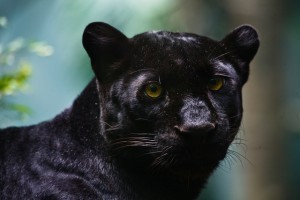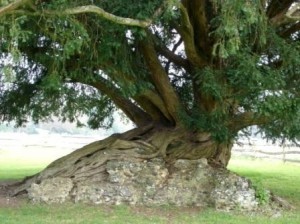Big Cats!
Still on the subject of cats today, although of a size larger than Dr Johnson's pet, Hodge, and your average domestic cat.
Interest in "big cats" in the UK has been sparked again by the case of "the wild cat of Woodchester," a big black cat thought to be the size of a puma which is reported to be attacking deer on the National Trust estate of Woodchester Park in the Cotswolds. (Woodchester Mansion is fabulous for a visit – here is the website and there is a photo below.) The result of DNA tests due this week should prove if this is a cat attack or not. Big cat incidents have been reported for years in the UK and divide opinion. Our last native big cat was the lynx, which died out in medieval times. This is borne out by pieces of linguist evidence; a 7th century lullaby lists the animals killed by a hunter and one of these is the "llewyn," which is thought to be translated as lynx. A medieval Welsh poem, Pa Gwr, recorded in the Black Book of Carmarthen, also mentions "cath Palug", a big cat.
 Jump to the 1960s and 1970s and it was both legal and fashionable to keep exotic big cats as pets. However in 1976 the government introduced the Dangerous Wild Animals Act amidst growing concern for public safety and also for the welfare of the animals. Owners were required to get a licence and ensure that the pets were kept in suitable conditions. As a result some big cat owners donated their pets to zoos. Others set them free to fend for themselves in the wild. It is therefore perfectly logical that subsequent reports of big cat activity in the UK could result from these releases. But what about the centuries in between the extinction of the lynx and the appearance of this new wave of big cats and their descendants? How can one explain big cat sightings from this period? Did the aristocrats who brought back antiquities from their travels abroad also return with exotic animals for their menageries which subsequently escaped or were released? Did the travelling circuses lose some of their exotic animals?
Jump to the 1960s and 1970s and it was both legal and fashionable to keep exotic big cats as pets. However in 1976 the government introduced the Dangerous Wild Animals Act amidst growing concern for public safety and also for the welfare of the animals. Owners were required to get a licence and ensure that the pets were kept in suitable conditions. As a result some big cat owners donated their pets to zoos. Others set them free to fend for themselves in the wild. It is therefore perfectly logical that subsequent reports of big cat activity in the UK could result from these releases. But what about the centuries in between the extinction of the lynx and the appearance of this new wave of big cats and their descendants? How can one explain big cat sightings from this period? Did the aristocrats who brought back antiquities from their travels abroad also return with exotic animals for their menageries which subsequently escaped or were released? Did the travelling circuses lose some of their exotic animals?
In the 1760s the author William Cobbett wrote in his Rural Rides that as a boy he had seen a cat the size of a medium-sized Spaniel dog climb into a hollow elm tree in the grounds of Waverley Abbey in Surrey (website here, another fabulous place to visit). A medium-sized spaniel isn't very big but Cobbett was later in Canada and saw a lynx there, which he commented was exactly like the cat he had seen at Waverley. Nor was he alone in his sighting. Newspaper reports from the 18th and 19th century also record reports of big cats. One in The Times from 1827 reported that a lynx had been seen in the UK. Another in 1927 reported a lynx trapped by a Scottish farmer. These reports raise the tantalising possiblity that the lynx never completely died out in Britain.
Waverley Abbey in Surrey (website here, another fabulous place to visit). A medium-sized spaniel isn't very big but Cobbett was later in Canada and saw a lynx there, which he commented was exactly like the cat he had seen at Waverley. Nor was he alone in his sighting. Newspaper reports from the 18th and 19th century also record reports of big cats. One in The Times from 1827 reported that a lynx had been seen in the UK. Another in 1927 reported a lynx trapped by a Scottish farmer. These reports raise the tantalising possiblity that the lynx never completely died out in Britain.
Another mythological explanation is given for the belief in big cats. For centuries there has existed the myth of the Black Dog, so famously explored in Conan Doyle's The Hound of the Baskervilles. This ghostly creature is said to haunt wild moorland and other remote places. Perhaps big cats are the modern successor to the myth of the ghostly black dog. As someone who has seen a big cat myself, many years ago in rural Somerset, I am awaiting the results of the tests from the Wild cat of Woodchester with a great deal of interest. What do you think? Do these "mythical" beasts, whether they are big cats, yetis, the Loch Ness Monster or other mysterious creatures really exist?
©2012 Nicola Cornick. All Rights Reserved.
.


